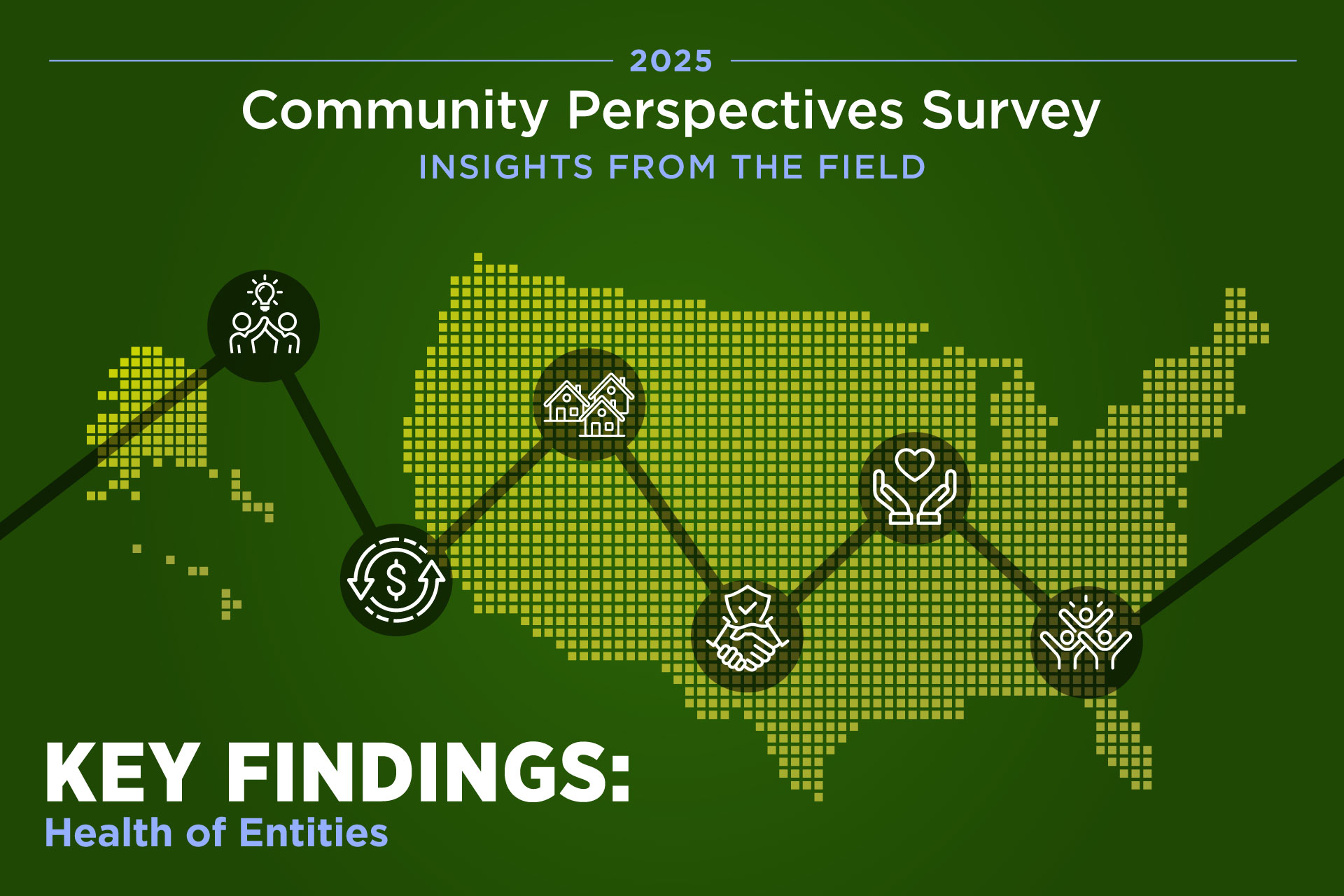2025 Community Perspectives Survey: Insights from the field—Health of entities serving low- and moderate-income communities


By Nishesh Chalise, Violeta Gutkowski, Steven Howland, Becky Kropf
August 19, 2025
This two-part report provides an overview of economic conditions in low- and moderate-income (LMI) communities and among the entities serving them based on a national survey conducted by the Federal Reserve during April and May 2025. This information is intended to help equip decision-makers with key insights for developing approaches to foster economic security in LMI communities.
Part 1 of this report addresses economic conditions in LMI communities, while part 2 focuses on the health of the organizations that work in them. Throughout, we offer quotes from those serving LMI communities to provide additional context to the survey results.
The survey asked respondents to provide self-assessment on various factors, including demand for services, ability to provide services, revenue, and expenses which are likely to impact their organization’s health. Overall, respondents indicated that they are able to serve their communities well, but that challenges with funding and lack of staffing are putting pressure on their ability to fully meet demand. Additionally, adapting to uncertainty is a new challenge that entities brought up in this survey.
Overall, entities responded positively in terms of their ability to serve their communities; however, they also reported considerable challenges. When asked about the entity’s current situation compared with last year, 80% reported an increase in demand for their services, while 83% reported increased expenses. Additionally, entities noted that funding and fundraising were their top challenges. These challenges have hampered entities’ ability to fully meet their demand for services; only about one-third of respondents reported being able to do so.
A majority of entities (76%) reported they are able to serve their communities well. Forty percent of respondents indicated that their ability to provide services has improved since 2024, and a similar percentage expect their ability to serve LMI communities to continue improving in the year ahead (Figure 1).
a. April 2025 (N=334)
b. Expectations for the year ahead (N=333)
Top challenges that entities expect will affect their ability to provide services over the next year (N=331):1
Entities’ financial health was mixed. About half of respondents indicated that their organizations are facing at least some stress, while the other half responded that they are doing fine. Specifically, 39% indicated that they are facing some stress and are trying to find efficiencies to save money; another 11% of entities reported being under a lot of stress and having to cut positions or programs (Figure 2). On the other hand, 34% of respondents described their financial health as steady with no changes expected for the year ahead, and another 14% indicated they are very healthy and are expanding services.
(N=319)
In April 2025, almost 80% of respondents reported that demand for services had increased over the preceding year, with 35% stating that demand had increased significantly (Figure 3). Higher demand places additional pressure on entities’ ability to meet the needs of LMI communities. Figure 4 shows that only about 10% of respondents were able to meet most (75%-100%) of their demand in 2024. While 30% of entities indicate that at the time of the survey, they could meet most of their demand. Only 15% of entities expect to meet most of their demand in the coming year.
Respondents noted that they expect a combination of a lack of funding, a lack of staff and/or volunteers, and an increase in demand to have an adverse impact on their ability to meet demand going forward.
“Federal uncertainty/changes are creating a huge drag on the organization—taking time, attention, and resources away from meeting demand/need for services.”
(N=323)
(N=272)
Top challenges that entities expect will affect their ability to meet demand for services over the next year (N=316):
Changes in staffing levels over the preceding year were mixed across respondents. Some entities (29%) reported an increase in their staffing levels, while others reported a decrease (27%) or no change (43%) since 2024. (Figure 5). Nearly twice as many respondents indicated staffing did not change as compared to either decreases or increases in staffing.
(N=317)
Top challenges that entities expect will affect their staffing levels over the next year (N=312):
During the survey period, 83% of respondents indicated that their entities had experienced increased expenses in the preceding year (Figure 6).
(N=319)
Top challenges that entities expect will affect their expenses over the next year (N=311):
The responses for changes in revenue compared with those of the preceding year were mixed across respondents. Figure 7 shows that 31% of respondents indicated that revenue had increased, 27% reported that revenue had remained unchanged, and 40% reported that it had decreased.
(N=318)
Government funds represented the top source of revenue for 35% of respondents, followed by fees for services (20%) and foundation funds (14%).
The following section (Figures 8 to 13) highlights how revenue from six different sources changed over the past year. Note that only entities identifying a particular source of revenue as one of their top three sources were asked about changes in that source. For example, if an organization did not include government funds as one of its top three sources of revenue, then the organization was not asked about changes in government funds.
More entities reported a decrease in funds than those reporting an increase across all sources except fees for services and credit/loans. Over 35% of the organizations relying on fees for services reported an increase in funding from this source over the past year. However, the organizations that saw the biggest increase in funding were those that relied on credit and loans, reporting a 41% increase.
Respondents did note a significant decrease in government funds. About 63% of entities for whom government funding was their top source of revenue reported experiencing a decrease compared to the previous year. Nearly a quarter of organizations relying on government funding reported their funding significantly decreased—the largest share for any funding source by a large margin.
“Our main fee-for-service contract has been dependent on the federal budget, and much of our funding has felt uncertain”
(N=194)
Funding from government funds decreased for 63% of respondents in the past year, while 13% reported an increase.
(N=131)
Funding from fees for services increased for 35% of entities, while 39% reported no change.
(N=101)
Funding from individual donations decreased for 38% of respondents in the past year, while it increased for 32% of respondents.
(N=111)
Funding from corporate donations decreased for 39% of respondents, while one-third did not see any changes.
(N=164)
Funding from foundation funds increased for 28% of respondents relative to 2024, while 29% reported a decline.
(N=51)
Funding from credit and loans increased for 41% of respondents, while 31% reported a decline.
| Does the entity you represent offer services directly to individuals and families? | |
|---|---|
| No | 17.0% |
| Unsure | 3.0% |
| Yes | 80.0% |
| To which type of geographic area does your entity dedicate the most resources? | |
| Equal across all geographic areas | 41.5% |
| Metropolitan | 40.0% |
| Rural (including frontier) | 18.5% |
| What type of geographic area does your entity serve? | |
| Nationwide | 11.0% |
| Statewide or multiple states | 24.0% |
| Within a county or some counties within a state | 37.0% |
| Within a metropolitan statistical area (MSA) | 28.0% |
1. Percentages are the share of respondents ranking the item as the No. 1 factor. Overall ranking is based on a weighted ranking of the top three factors.
The Federal Reserve System performs five key functions that serve all Americans and promote the health and stability of the U.S. economy and financial system. Understanding the obstacles that may hinder lower-income and under-resourced communities’ greater participation in the economy offers the Federal Reserve valuable insight into the challenges they, and the entities that serve them, face. To that end, from 2020 to 2023, the Federal Reserve System conducted surveys, called “Perspectives from Main Street,” to better identify the range of challenges facing LMI communities as an effect of the COVID19 pandemic. In 2024, the survey was renamed “Community Perspectives,” and it continues as a national survey aimed at reporting the economic conditions of LMI communities and the health of entities serving them. This survey has two objectives:
The most recent survey was open from April 14, 2025, to May 23, 2025. Responses were collected through a convenience sampling method that relied on contact databases to identify representatives of nonprofit organizations, financial institutions, government agencies and other community organizations. These representatives were invited to participate in the survey via emails, newsletters and social media posts. The survey had a total of 440 responses from entities that serve LMI communities. However, the total number of responses across sectors could differ since not all entities serve in all areas. Respondents were asked to select a topic area based on their entities’ top programming areas and to answer questions related to that sector specifically and not others.
Views expressed are those of the report team and do not necessarily represent the views of the Federal Reserve System.
Please cite this report as: Chalise, Nishesh, Violeta Gutkowski, Steven Howland, and Becky Kropf. “Community Perspectives Survey: Insights from the Field – Health of entities serving low- and moderate-income communities,” August 2025.
The Federal Reserve’s community development function seeks to promote the economic resilience and mobility of low- to moderate-income and underserved households and communities across the United States. We thank the following survey team members for their contributions:
Sydney Diavua, Federal Reserve Bank of St. Louis
Karen Leone de Nie, Federal Reserve Bank of Atlanta
Nick Sly, Federal Reserve Bank of Kansas City
Surekha Carpenter, Federal Reserve Bank of Richmond
Nishesh Chalise, Federal Reserve Bank of St. Louis
Violeta Gutkowski, Federal Reserve Bank of St. Louis
Steven Howland, Federal Reserve Bank of Kansas City
Matthew Klesta, Federal Reserve Bank of Cleveland
Becky Kropf, Federal Reserve Bank of Kansas City
Lisa Nelson, Federal Reserve Bank of Cleveland
Whitney Felder, Fed Communities
Crystal Flynn, Fed Communities
Natalie Karrs, Federal Reserve Bank of Cleveland
Melissa Kueker, Federal Reserve Bank of St. Louis
Nicholas A. Ledden, Federal Reserve Bank of St. Louis
Derek Stacey, Federal Reserve Bank of Cleveland
Allyson M. Sykora, Federal Reserve Bank of St. Louis
Amy Brewer, Federal Reserve Bank of Richmond
Suzanne Cummings, Federal Reserve Bank of Boston
Michelle Dailey, Federal Reserve Bank of St. Louis
Steven Howland, Federal Reserve Bank of Kansas City
Molly Hubbert Doyle, Federal Reserve Bank of Dallas
Kellye Jackson, Federal Reserve Bank of New York
Elizabeth Kneebone, Federal Reserve Bank of San Francisco
Susan Longworth, Federal Reserve Bank of Chicago
Grace Meagher, Federal Reserve Bank of Atlanta
Ryan Nunn, Federal Reserve Bank of Minneapolis
John Rees, Federal Reserve Bank of Atlanta
Edison Reyes, Federal Reserve Bank of New York
Brianna Smith, Federal Reserve Bank of Chicago

Industrial flex space has become a quiet favorite among sophisticated investors seeking durable income backed by real business demand. If...

Getting an inheritance is the epitome of a mixed blessing. You receive a financial windfall, but the cause is the...

During his tenure as the California Secretary of Health and Human Services, Mike Wilkening cemented his reputation as a steady...